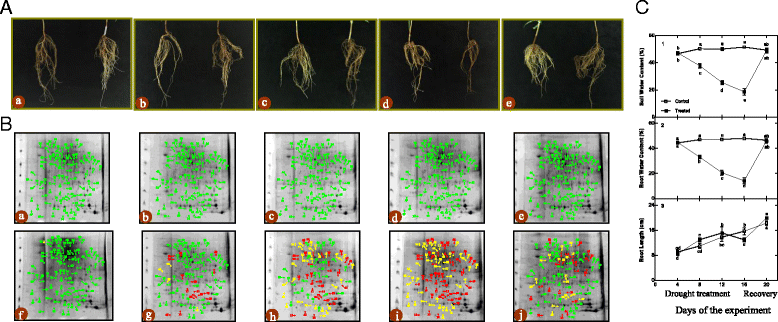Physiological and proteomic analyses of the drought stress response in Amygdalus Mira (Koehne) Yü et Lu roots
- PMID: 28241796
- PMCID: PMC5327565
- DOI: 10.1186/s12870-017-1000-z
Physiological and proteomic analyses of the drought stress response in Amygdalus Mira (Koehne) Yü et Lu roots
Abstract
Background: Plants are oftentimes exposed to many types of abiotic stresses. Drought is one of the main environmental stresses which limits plant growth, distribution and crop yield worldwide. Amygdalus mira (Koehne) Yü et Lu is an important wild peach, and it is considered an ideal wild peach germplasm for improving cultivated peach plants. Because of the loss of genetic variation, cultivated peach plants are sensitive to biotic and abiotic stresses. Wild peach germplasm can offer many useful genes for peach improvement. Responses to drought by withholding water have been studied in Amygdalus mira (Koehne) Yü et Lu roots. In this study, plants were divided into well-watered (control) and water-stressed (treatment) groups, and the treatment group did not receive water until the recovery period (day 16).
Results: Several physiological parameters, including root water content and root length, were reduced by drought stress and recovered after rewatering. In addition, the relative conductivity, the levels of proline, MDA and H2O2, and the activities of ROS scavenging enzymes (POD, APX and CAT) were increased, and none of these factors, except the level of proline, recovered after rewatering. In total, 95 differentially expressed proteins were revealed after drought. The identified proteins refer to a extensive range of biological processes, molecular functions and cellular components, including cytoskeleton dynamics (3.16% of the total 95 proteins), carbohydrate and nitrogen metabolism (6.33% of the total 95 proteins), energy metabolism (7.37% of the total 95 proteins), transcription and translation (18.95% of the total 95 proteins), transport (4.21% of the total 95 proteins), inducers (3.16% of the total 95 proteins), stress and defense (26.31% of the total 95 proteins), molecular chaperones (9.47% of the total 95 proteins), protein degradation (3.16% of the total 95 proteins), signal transduction (7.37% of the total 95 proteins), other materials metabolism (5.26% of the total 95 proteins) and unknown functions (5.26% of the total 95 proteins). Proteins related to defense, stress, transcription and translation play an important role in drought response. In addition, we also examined the correlation between protein and transcript levels.
Conclusions: The interaction between enzymatic and non-enzymatic antioxidants, the levels of proline, MDA, H2O2 and the relative conductivity, and the expression level of proteins in drought-treated plants all contribute to drought resistance in Amygdalus mira (Koehne) Yü et Lu.
Keywords: Amygdalus mira (Koehne) Yü et Lu; Drought; Physiological; Proteomics; Wild peach.
Figures






Similar articles
-
Physiological and Proteomic Responses to Drought in Leaves of Amygdalus mira (Koehne) Yü et Lu.Front Plant Sci. 2021 Jun 24;12:620499. doi: 10.3389/fpls.2021.620499. eCollection 2021. Front Plant Sci. 2021. PMID: 34249029 Free PMC article.
-
The cotton WRKY transcription factor GhWRKY17 functions in drought and salt stress in transgenic Nicotiana benthamiana through ABA signaling and the modulation of reactive oxygen species production.Plant Cell Physiol. 2014 Dec;55(12):2060-76. doi: 10.1093/pcp/pcu133. Epub 2014 Sep 26. Plant Cell Physiol. 2014. PMID: 25261532
-
PmRad23d Interacts With PmSRC2 and PmCAR4 to Mediate the Abscisic Acid-Dependent Drought Response in Prunus mira Koehne.Plant Cell Environ. 2025 Jun;48(6):4178-4195. doi: 10.1111/pce.15418. Epub 2025 Feb 9. Plant Cell Environ. 2025. PMID: 39924854
-
Proteomics and phosphoproteomics reveal the different drought-responsive mechanisms of priming with (Z)-3-hexenyl acetate in two tea cultivars.J Proteomics. 2023 Oct 30;289:105010. doi: 10.1016/j.jprot.2023.105010. Epub 2023 Oct 4. J Proteomics. 2023. PMID: 37797878 Review.
-
Proteomic approaches to uncover the flooding and drought stress response mechanisms in soybean.J Proteomics. 2018 Feb 10;172:201-215. doi: 10.1016/j.jprot.2017.11.006. Epub 2017 Nov 11. J Proteomics. 2018. PMID: 29133124 Review.
Cited by
-
Drought-tolerant Bacillus megaterium isolated from semi-arid conditions induces systemic tolerance of wheat under drought conditions.Plant Cell Rep. 2022 Mar;41(3):549-569. doi: 10.1007/s00299-020-02640-x. Epub 2021 Jan 7. Plant Cell Rep. 2022. PMID: 33410927
-
iTRAQ-based quantitative proteomic analysis of heat stress-induced mechanisms in pepper seedlings.PeerJ. 2021 Jun 3;9:e11509. doi: 10.7717/peerj.11509. eCollection 2021. PeerJ. 2021. PMID: 34141478 Free PMC article.
-
Physio-Morphological, Biochemical and Transcriptomic Analyses Provide Insights Into Drought Stress Responses in Mesona chinensis Benth.Front Plant Sci. 2022 Feb 10;13:809723. doi: 10.3389/fpls.2022.809723. eCollection 2022. Front Plant Sci. 2022. PMID: 35222473 Free PMC article.
-
Metabolic adjustment and regulation of gene expression are essential for increased resistance to severe water deficit and resilience post-stress in soybean.PeerJ. 2022 Mar 18;10:e13118. doi: 10.7717/peerj.13118. eCollection 2022. PeerJ. 2022. PMID: 35321407 Free PMC article.
-
The genome sequence of Aloe vera reveals adaptive evolution of drought tolerance mechanisms.iScience. 2021 Jan 21;24(2):102079. doi: 10.1016/j.isci.2021.102079. eCollection 2021 Feb 19. iScience. 2021. PMID: 33644713 Free PMC article.
References
Publication types
MeSH terms
Substances
LinkOut - more resources
Full Text Sources
Other Literature Sources
Miscellaneous

